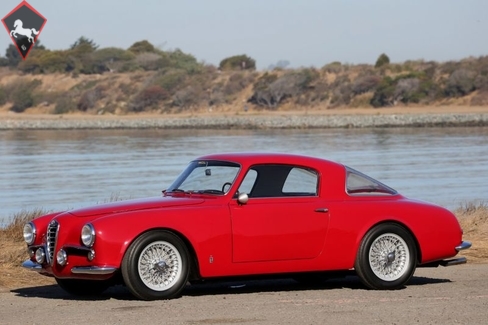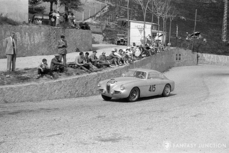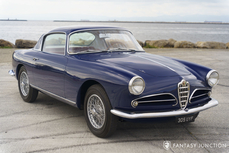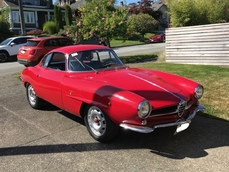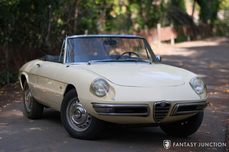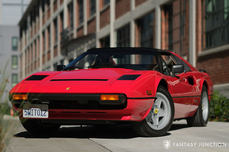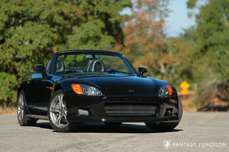Alfa Romeo 1900 C Sprint 1.9 Liter DOHC 4-Cylinder no. AR1306*18248* 1953
General description :
1953 Alfa Romeo 1900 CS. Pinin Farina Berlinetta
s/n AR 1900C *01534*, Engine no. AR 1306 *18248*
Deep Red with Black Leather
Launched in 1950 at the Paris Motor Show, the Alfa Romeo 1900 was a significant technical leap for the growing company. The 1900 was the first Alfa Romeo designed and built for production assembly and would also be the first Alfa Romeo available in left-hand drive. Offered in both four-door Berlina and two-door Sprint variants, the car was initially powered by a 1,884cc, 4-cylinder twin cam engine producing around 90 horsepower. Racing success immediately followed in the Targa Florio and Stella Alpina rallies. Alluding to recent and forthcoming victories, Alfa Romeo marketed and promoted the 1900 as “the family car that wins races”. In 1951, Alfa Romeo released the shorter 2.5 meter wheelbase 1900C, followed quickly by introducing a more powerful engine option for the cars as the 1900 “Sprint”. The Sprint option was equipped with a bored-out 1,900cc engine producing 100 horsepower. Approximately 100 of the performance-oriented, short-wheelbase 1900s were delivered with the more powerful Sprint engines to famed Italian coachbuilder Pinin Farina. Pinin Farina designed the very elegant coupe body known as the 1900 “Corto” Sprint. The unique platform design and performance engine enticed other notable coachbuilders including Touring, Zagato and Bertone, however the alloy bodied Pinin Farina cars are among the rarest 1900s with approximately fifty cars having been built in this configuration.
Via Fantasy Junction, the current owner purchased this 1900 CS from an esteemed Northern California collector with multiple highly prized vehicles in his personal collection. A few of cars include a Pebble Beach Concours award winning Aston Martin DB2/3 DHC, a Mercedes 300SL Roadster, a Porsche Speedster and a Lancia B24 Aurelia Cabriolet along with arguably one of the finest SIATA 208S in existence. Having enlisted expert Raffi Najjarian of The Pit Stop, a great deal of work was performed on the car’s mechanical components while freshening the interior and refining the several cosmetic aspects of the exterior.
The engine rebuild was performed with the goal to bring the car up beyond CSS specifications. This rebuild included the installation of a CSS crankshaft, larger pistons, and dual Weber 44 DCO carburetors feeding into an Abarth intake manifold and exiting from newly installed exhaust. The final rebuild was dialed in and refined bringing power up to roughly 150hp. Further work included the installation of an oil cooler, electric fuel pump, new fuel tank, and a supplementary electric cooling fan, all of which required redoing the electrical with new wiring as needed. Substantial time was further spent improving the car’s driving dynamics. Inclusive of the suspension rebuild, all new Alfins drum brakes were installed and the front A-arms were updated to a 2500 system and a rebuilt steering box. The original column mounted four-speed transmission was updated to a newer a five-speed gearbox with a floor-mounted shifter and a new clutch. As the mechanical work was completed, the engine bay was fastidiously detailed and carefully finished with as many authentic components as possible. The current custodian purchased the car from Fantasy Junction four years ago and has the Alfa Romeo experts at Dominick’s European Car Repair maintain and service the car as needed to include regular fluid changes and wheel alignments. Under his ownership just over 1,700 miles were logged.
Today this handsome Pinin Farina 1900 CS presents very nicely with a quality high gloss finish, and good panel fit. The doors open and shut easily. The engine cover appears slightly proud at the passanger’s side the leading edge. There are a few superficial stone chips in various areas, two of which appear of the passenger side rocker panel, but none of which effect the overall presentation of the car. The grille and eyebrow openings were re-chromed during the refresh, and still offer gleaming reflections. The rear bumpers and chromed decklid are also very nicely presented. The absence of further garnish molding and chrome trim is a welcome relief from often overdone cars of this period. In keeping with the performance theme, the car is finished with beautiful Borrani wire wheels and correct spare tire were rebuilt, powder-coated, and fit with correct knock-off spinners during the restoration, giving the car an authentic appearance, enhancing the high quality driver presentation. The exterior door handles show some light pitting and while the windshield shows light scratches, the remaining glass presents nicely including the unique wrap around rear window.
The interior reflects the performance lineage with a focus on spirited driving. The seat rails and locking mechanisms were rebuilt during the refresh and a set of vintage style competition seat belts were installed. The leather covered rally-style Zagato seats complete the performance picture, giving excellent lateral support, particularly when compared against the formerly staid bench seat. The cloth headliner and sun visors are clean and taut, while the rear parcel shelf and leather straps offer a nice finishing touch to the interior. In the trunk, a new tool kit and jack were purchased and fitted along with a plug-in lamp. The shifter falls very nicely to hand with a smooth metal ball on the top of the shifter and a supple leather boot at the base of the shifter. The dashboard may have been replaced but is well-fitted to the car, featuring nice instrumentation with clean lenses, crisp numbers, and handsome lettering. A safety kill switch is located under the left side of the dash. The interior is handsomely finished with a period correct flat Nardi wooden steering wheel, accented by the Alfa Romeo center insignia. The trunk is nicely finished with satin black finish, proper floor mat, and a distinctive optional touch – a hand held spot light, convenient for rally road repairs, particularly effective in evening or sunset events.
The engine compartment has been nicely maintained since the rebuild, continuing to feature correct finishes, authentic parts, proper lines and materials, offering a uniform finish and slight patina resulting from recent but only minor use. During the rebuild, the upgraded engine and twin Weber carburetor intake was carefully added with the intent of retaining an authentic appearance and presentation. The undercarriage presents with no evidence of structural compromise and while not detailed for show, all components are clean, dry, and tidy.
Having been properly serviced and wonderfully updated, the car drives very smoothly, on the street or as an ideal competitor in rally or touring events, including completing multiple California Mille events and other rallies. The car performs well from a cold start with good oil pressure and proper running temperatures. The brakes operate confidently with good pedal pressure and no pulsing. Steering is tight and true with no signs of play or notching through the rebuilt steering box. The driving experience in this particular 1900 benefits tremendously form the combined suspension, motor upgrades, and Zagato-style seats, literally transforming an already fine car into a wonderfully handling touring car. The twin Weber carbureted engine makes excellent power in all gears with ratios ideally spaced for road or highway use, moving in harmony with the reworked suspension. Alfa Romeo 1900s are known for their willingness in corners when properly and spiritedly driven. In the case of this specific 1900 the driver will be especially delighted by the performance and reliability. Accompanying the car is a set of tools, tool roll, and a matching wire spare wheel.
This is a great opportunity to acquire an event-eligible rare Pinin Farina bodied Alfa Romeo combining professionally refined mechanical improvements with a delightful visual presentation in a wonderfully drivable road car. The combination of exterior grace and road-going performance, coupled with delightful driving manners makes this 1900 CS a great classic rally or event car. For those who admire hand made coachwork, state of the art engineering, and exciting driving, this Alfa Romeo 1900 CS will deliver ongoing rewards throughout your ownership experience.
http://fantasyjunction.com/cars/1559-Alfa%20Romeo%20-1900%20CS%20Pinin%20Farina%20%20%20%20%20Berlinetta-1.9%20Liter%20DOHC%204-Cylinder
1953 Alfa Romeo 1900 C Sprint 1.9 Liter DOHC 4-Cylinder no. AR1306*18248* is listed sold on ClassicDigest in Emeryville by Fantasy Junction for $375000.
Car Facts
Car type : Car Make : Alfa Romeo Model : 1900 C Sprint Model Version : 1.9 Liter DOHC 4-Cylinder no. AR1306*18248* Engine size : 1.9 Model Year : 1953 Location : Emeryville
Sold
Seller Information
Sold
People who viewed this Alfa Romeo 1900 C Sprint also viewed similar Alfa Romeo listed at ClassicDigest
Other cars listed for sale by this dealer
About Alfa Romeo 1900 C Sprint
The Alfa Romeo 1900 C Sprint is a classic sports car produced by Alfa Romeo from 1951 to 1953. Here's an overview of its specifications and development history:Specifications:
1. Engine: The 1900 C Sprint was powered by a 1.9-liter inline-four engine, featuring an aluminum block and cylinder head. It had a single overhead camshaft and was equipped with dual Weber carburetors. The engine produced around 100 horsepower, providing impressive performance for its time.
2. Transmission: The car came with a four-speed manual transmission, delivering power to the rear wheels. It featured a floor-mounted gear shifter for precise gear changes.
3. Suspension and Brakes: The 1900 C Sprint utilized independent front suspension with coil springs and a solid axle with leaf springs at the rear. It had hydraulic drum brakes on all four wheels, ensuring reliable stopping power.
4. Design: The 1900 C Sprint featured a sleek and aerodynamic design, characterized by its rounded front grille, prominent fenders, and elegant proportions. It had a two-door coupe body style, offering seating for up to four passengers. The design was influenced by Alfa Romeo's racing heritage, incorporating elements for improved performance and handling.
Development History:
1. Introduction: The Alfa Romeo 1900 C Sprint was introduced as a more sporting variant of the original 1900 sedan. It was designed to cater to enthusiasts who desired a powerful and stylish sports car that could also be used for everyday driving.
2. Lightweight Construction: The 1900 C Sprint featured a lightweight construction compared to the sedan model. It utilized aluminum body panels and had a reduced overall weight, contributing to improved performance and handling characteristics.
3. Limited Production: The 1900 C Sprint was produced in limited numbers, with around 854 units built during its production run. This exclusivity adds to its desirability among collectors and enthusiasts today.
4. Racing Success: The 1900 C Sprint's performance capabilities and handling prowess led to success in motorsport. It competed in various racing events, including the Mille Miglia, where it achieved notable results and helped solidify Alfa Romeo's racing reputation.
The Alfa Romeo 1900 C Sprint is highly regarded among classic car enthusiasts for its beautiful design, impressive performance, and racing heritage. It represents a significant chapter in Alfa Romeo's history, showcasing the brand's commitment to producing elegant yet sporty automobiles. Today, well-maintained examples of the 1900 C Sprint are sought after by collectors who appreciate its rarity, historical significance, and the joy of owning a piece of automotive history.
